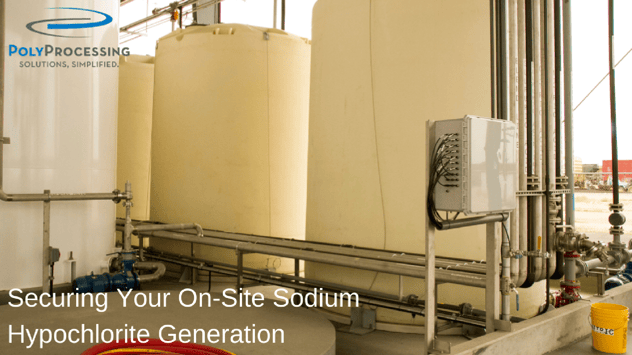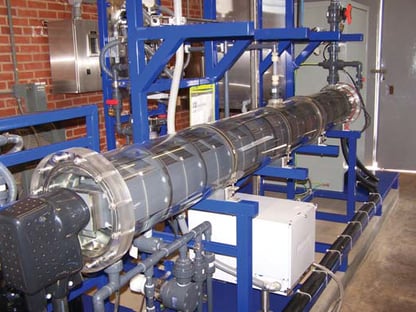Securing Your On-Site Sodium Hypochlorite Generation

Sodium hypochlorite (NaOCl) is an NSF/ANSI 61 approved chemical at a 15% concentration or less for Poly Processing’s tank systems.
Sodium hypochlorite is an aggressive oxidizer that presents a significant storage challenge. Three main issues must be considered: First, UV can degrade sodium hypochlorite. Secondly, sodium hypochlorite typically contains transition metals such as nickel, iron, and copper, which can build up in a storage tank, creating off-gassing. Finally, sodium hypochlorite is a potent oxidizer, so all materials in the chemical storage tank must be up to the task. By addressing all three of these issues, this aggressive chemical can be contained securely and safely.
Let’s take a closer look at how sodium hypochlorite is used, how it’s made on-site, and how you can safely store it.
Common Uses of Sodium Hypochlorite
Sodium hypochlorite is used in a variety of applications, particularly for disinfecting drinking water and wastewater in treatment plants. Additional applications include commercial swimming pools, dairy farm animal hygiene, and food service equipment services.
Sodium hypochlorite is often preferred over chlorine for a variety of reasons, including chlorine’s lingering toxicity, ongoing repurchase expense, increasing regulatory compliance, and a variety of safety concerns associated with transport and storage.
Two Main Ways of Using Sodium Hypochlorite
There are two main ways of supplying sodium hypochlorite for use. One way is by shipping 12% to 15% sodium hypochlorite via bulk delivery. However, there is a challenge in that transporting sodium hypochlorite can be difficult and expensive in rural areas where the distance to the facility is great, or where a large truck does not have access to the plant do to its location, etc.
The second way sodium hypochlorite is used is in a process called on‐site sodium hypochlorite generation (OSHG). Many water and wastewater facilities prefer this method, because it overcomes the challenges of bulk delivery, including safety, truck traffic, price variability, sustainability, and overall lifecycle costs.
How On-site Sodium Hypochlorite Generation Is Done
 OSHG is a relatively simple process that uses electrolysis of salt water to produce the chlorinated solution. This occurs when a saltwater brine is run through electrolyzed cells inside of polycarbonate tubes. As salt passes through the tubes at a low voltage, the electrolysis is triggered and low concentration sodium hypochlorite is created.
OSHG is a relatively simple process that uses electrolysis of salt water to produce the chlorinated solution. This occurs when a saltwater brine is run through electrolyzed cells inside of polycarbonate tubes. As salt passes through the tubes at a low voltage, the electrolysis is triggered and low concentration sodium hypochlorite is created.
Next, the hydrogen-rich sodium hypochlorite travels to a tank that pulls off the hydrogen gas. The sodium hypochlorite solution is then stored in a tank as a low-concentration finished product at .8% to 1% concentration. (Note: Proper production and storage of the saltwater brine requires a unique combination of features and design. Cross-linked polyethylene offers an ideal storage option for brine, as well as sodium hypochlorite.)
How to Safely Store Low Concentrations of Sodium Hypochlorite
Sodium hypochlorite is an aggressive oxidizer with a relatively short shelf life. As a result, it’s recommended that this chemical is stored in a high-density cross-linked polyethylene (XLPE) tank with the next generation OR-1000 system as part of the design. These tanks are specifically designed to address the aggressive oxidation effects of sodium hypochlorite at both concentrations (12% and .8%). Also, by using carbon black, white, or gray compound XLPE resin, UV degradation of the chemical can be dramatically reduced. Further, to prevent the potential buildup of transition metals in the tank, a special integrally molded design fitting called the IMFO allows for full drainage of the tank, which can greatly increase the half-life of the chemical.
Another critical component of sodium hypochlorite storage is having a seamless bond between the inner surface of OR-1000 and the outer surface of high-density crosslinked polyethylene. The next generation OR-1000 engineered inner surface is made of medium-density polyethylene, specifically formulated to resist oxidation. The tanks outer surface is made of XLPE for superior strength. These storage tank advantages give the owner longevity and peace of mind, knowing the tank is built for sodium hypochlorite from the ground up. The tank system is a 1.90 SPG XLPE tank with OR-1000 interior resin ,PVC fittings, Viton gaskets, and titanium bolts for concentrated sodium hypochlorite and 1.65 SPG XLPE tank with PVC fittings, Viton Gaskets, and titanium bolts for .8% concentration..
To learn more about how you can ensure proper storage of sodium hypochlorite, contact a chemical storage tank expert today.
- October 20, 2016
About Poly Processing
Posts By Topic
Tech Talk Podcast Episodes
Subscribe By Email
Recent Posts
- Protect Your Facility and Your Bottom Line with a Chemical Leak Detection System
- PPC Installation, Operation, and Maintenance Manual: Ensure Tank Longevity
- How To Use The Chemical Resistance Guide
- Better and Safer Alternatives to Downpipes
- Crosslinked Polyethylene Vs. Fiberglass Reinforced Plastic Tanks
Tank Configurator

Find the recommended tank and system components for your chemical storage challenge.
Configure a Tank Package


